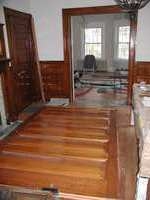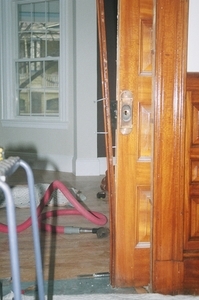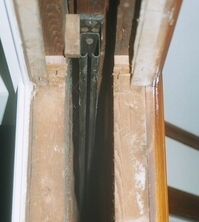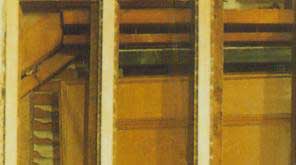This is a large single door which was scraping the floor. It had a Coburn channel with trolley type wheels. From experience, I suspected that the track/channel carrying board had dropped away from the house framing member.
A "feeler gauge" or probe can be fashioned from a length of stiff wire. I use acoustical ceiling wire, at the end of which I place a one inch 90 degree bend. Placing this in the upper regions above the door, it is possible to check for any gap between the house framing member and the track carrying board.
I demonstrated that the track board had indeed slumped down-not a great deal, but enough to cause problems. The owner gave the "go ahead" for the repairs. Four kinds of trim were removed- 1) the header (overhead) trim, 2) the jamb (vertical) trim at the entrance to the pocket, 3) the multi-part jamb trim covering the demi-pocket and 4) the meeting molding on the leading edge of the door.
Two lengths of Coburn channel were present. One was wholly situated in the pocket. While standing in the open doorway area, I removed the other channel-overhead. Then, with a piece of sheet metal protecting the floor, the door was pulled out from the pocket.
recent repair of a wide single door
This door is 55" wide and 1 3/4" thick-very heavy. I was prepared to move the door away from the opening with a massive antique 2 wheel hand truck. But as a precaution against bending or distorting the door hanger straps, I removed the wheel assemblies-and found a concealed defect!
Both pairs of riser straps had been altered. Someone had taken a file or a saw and enlarged the original punched hole. (What were they thinking?) What I was looking at was not "fair wear and tear." The former hole had been distorted into a misshapen rectangle. This ill conceived alteration had the effect of dropping the door. Thus, there were now two separate causes which accounted for the door dragging on the floor.
So...to remedy this newly uncovered defect, appropriate riser straps were made from identical gauge steel & were fitted into the existing door hangers. See blue straps in photos.
In this photo (taken from another job) the top horizontal stout timber is a framing member inserted at the time the wall was being built. It is nailed to the (vertical) studs (from the side-nails driven horizontally). It is never a problem. Remains at the height at which it was positioned
But the lower horizontal board, called the track carrying board or channel carrying board was typically nailed to the framing member-and these nails were driven vertically. I'll say it again-the perennial problem (I find) is that the installers used nails to attach the thin board to the thick board. They should have used screws. As time passed, it was probable that the weight of the door (as well as the vibration from the door being moved in and out of the pocket) would cause the channel carrying board to drop away from the framing member. This is the most prevalent reason (with an enclosed channel/trolley type hanger system) we find that the door is dragging on the floor.
Decades ago, people knew about the adjustment screws that the manufacturers had incorporated into their channels. And we can assume that when a pocket door started scraping the floor, homeowners or handymen of those days knew about raising the channel by turning the adjustment screws. But when the full potential of the adjustment screws had been realized, and the doors were once again dragging on the floor...it is no wonder that people stopped using the doors or boarded them up or converted the openings into French doors.
Here is another photo from an exposed wall situation. There was a fire in this home and the first floor walls were gutted. You can see clearly the stout framing member and the gap beneath it. Visible are several 3" long (size No. 12) wood screws ready to be driven upwards in order to raise the channel carrying board.
This is easy to do when the side of the wall is exposed. But, as it says in my flyer, it is not necessary to demolish the side walls to repair pocket doors. My purpose-made 6' long drill tools make it possible to accomplish this while standing in the middle of the opening. In the case of wide doors (which of course entails working with deep pockets), I also use a small hydraulic jack. I slide it into the deepest part of the pocket and use an appropriate length of wood or black iron pipe to jack up the end of the track carrying board. Then I predrill holes and insert the screws with my 6' special purpose tools.













